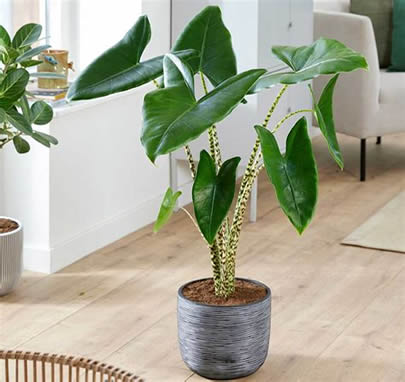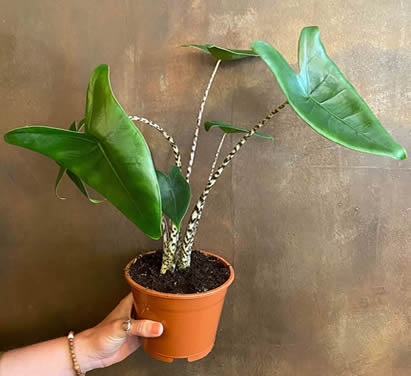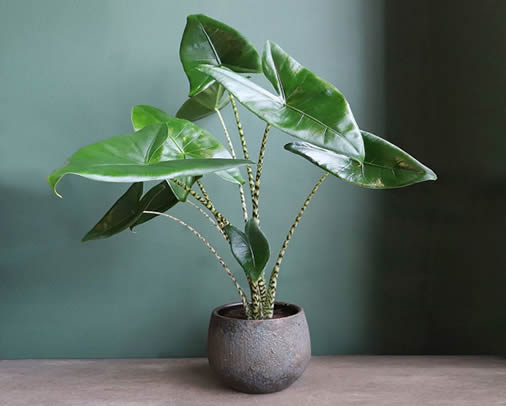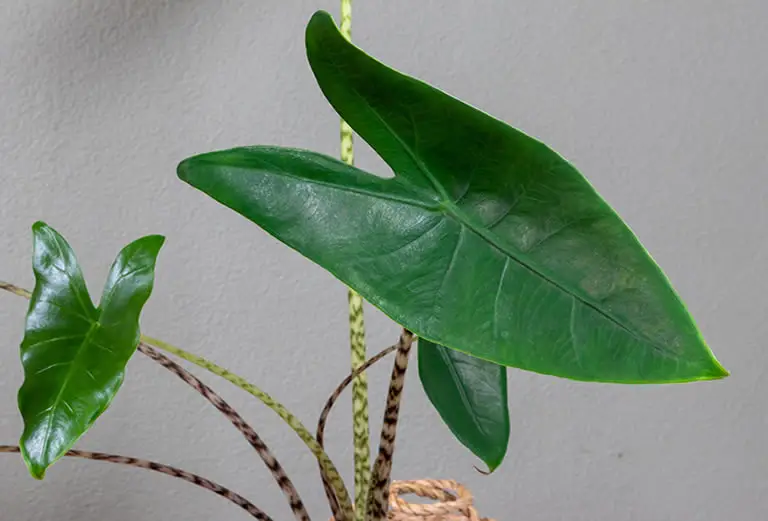Alocasia Zebrina might just be the fashion model of the plant world. With its slim, tiger-striped stalks and arrow-shaped foliage, it brings a bold, tropical statement to any indoor space. While it’s not the easiest plant on the block, with the right setup and care, your Zebrina will absolutely flourish.
This unique houseplant thrives in warm temperatures, appreciates consistently moist (but never soggy) soil, and craves bright, indirect light.
It’s a humidity lover and tends to grow fairly fast during the warmer months, especially if fed every two weeks.
Just don’t be surprised if it takes a nap in winter—it’s totally normal for it to go dormant. And like many Alocasias, it’s toxic to pets and people, so admire it with care!
Table of Contents
- What Makes the Alocasia Zebrina Special
- Bright, Indirect Light is a Must
- Watering: Less Is More (But Not Too Little!)
- Choosing the Right Soil
- Keep It Toasty and Humid
- Feeding and Fertilizing
- Flowers Aren’t the Star Here
- Pruning and Grooming
- Repotting: Less Is More
- Propagation Through Division
- Troubleshooting Dormancy and Leaf Loss
- A Note on Toxicity
- One Plant, Many Names
- Pests and Diseases
What Makes the Alocasia Zebrina Special
This tropical stunner doesn’t just have showy leaves—it’s actually the stems that steal the spotlight.

They’re slender and striped like a zebra, hence the name.
Native to the rainforests of the Philippines, Zebrina naturally grows beneath jungle canopies in bright shade, soaking up diffused light at high elevations.
When grown indoors, Alocasia Zebrina can reach up to three feet tall and wide.
It’s a pretty quick grower in the right conditions, often popping out new leaves every couple of weeks during the active growing season.
As new foliage emerges, older leaves naturally fade and fall off—nothing to worry about there.
Bright, Indirect Light is a Must
Alocasia Zebrina thrives in bright, indirect sunlight.
While it enjoys soaking up lots of light, direct rays—especially midday sun—can scorch its leaves.
A spot near a bright window with a sheer curtain is ideal.
You can also place it a few feet back from a sunny window or give it some gentle morning sun from an east-facing window.
Keep in mind, this plant will lean dramatically toward the light if left alone, so give the pot a quarter-turn each time you water to keep it growing evenly.
Watering: Less Is More (But Not Too Little!)
This plant is particular about water. It likes its soil slightly moist, but never soggy.
Thanks to its moisture-retaining stalks, it doesn’t need large doses of water at once—in fact, it’s better to water small amounts more frequently than drenching the pot every time.

Let the top half-inch of soil dry out before watering again.
During the cooler months or dormancy, allow the top two inches to dry.
A good trick? Pick up the pot to feel the weight—when it’s light, it’s likely ready for a drink.
Just don’t follow a strict schedule—check the soil and let the plant guide you.
Choosing the Right Soil
Alocasia Zebrina needs a loose, well-aerated mix that drains quickly while still holding some moisture.
A combo of peat, perlite, and compost or worm castings works well.
Avoid compacted or heavy soil—it holds onto water and can suffocate roots.
You can also toss in a bit of pumice or coarse sand for extra airflow.
Interestingly, some growers have success growing Alocasia Zebrina in water.
It sounds odd, but water offers better gas exchange than soggy soil.
If you want to try this, clean the roots thoroughly and keep the plant in fresh, dechlorinated water, changing it weekly. Filtered or rainwater works best.
Keep It Toasty and Humid
Zebrina prefers it warm and humid, just like the rainforest it came from.
Keep temperatures between 60°F and 82°F (15–28°C) and avoid cold drafts or drastic temperature changes.
Anything below 60°F can trigger dormancy or leaf loss.
Humidity-wise, aim for 60% or higher. A humidifier is ideal, especially in winter.
You can also place it on a pebble tray or group it with other tropicals to boost the local humidity.
Feeding and Fertilizing
Alocasia Zebrina is a moderate to heavy feeder when actively growing.
Use a balanced liquid fertilizer diluted to half strength every two weeks during the growing season.
Alternatively, you can use a slow-release fertilizer every 4–6 weeks.
Avoid feeding during winter dormancy—too much fertilizer during this period can harm the roots.
If you’re using synthetic formulas, remember to flush the soil occasionally to prevent salt buildup.
Flowers Aren’t the Star Here
Though the plant may occasionally produce small hooded spathes in spring, they’re not very impressive and don’t last long.
The real draw will always be those exotic striped stems.
Pruning and Grooming
There’s not much pruning required.
Just remove yellow or damaged leaves with sterile scissors, cutting close to the base without nicking the main stalk.
If you want to encourage smaller leaves, you can remove older ones and adjust light and feeding to suit.
Always wear gloves when pruning—Zebrina’s sap can irritate the skin.
Repotting: Less Is More
This plant doesn’t love being disturbed. Wait until it’s truly rootbound—usually when the roots start growing through the drainage holes or it needs watering constantly.
When repotting, go up only one pot size and use fresh, similar soil.
Hold off on watering heavily right after repotting.
The root system needs time to adjust and doesn’t want to sit in extra moisture.
Propagation Through Division
Alocasia Zebrina grows in clumps, making it perfect for propagation via division.

Gently remove the plant from its pot, clean off the soil, and separate any offsets or tubers with small roots.
You can plant them in soil or water and treat them like mature plants once they show signs of new growth.
Troubleshooting Dormancy and Leaf Loss
If your Zebrina drops some leaves during cooler months, don’t panic—it might be going dormant.
Cut back on watering and resume regular care once new growth appears.
Make sure to investigate if it’s not seasonal, though.
Dormancy can also be triggered by stress from dry soil, low light, or root damage.
A little shedding of older leaves is normal, but if the plant looks sparse, check for pests, overwatering, or other care issues.
And don’t forget to wipe the leaves occasionally to keep them clean and pest-free.
A Note on Toxicity
This beauty may be bold, but she bites. Alocasia Zebrina contains calcium oxalate crystals that can irritate skin and cause mouth or digestive issues if ingested.
Keep it out of reach of pets and little ones.
One Plant, Many Names
You might come across names like Alocasia Tigrina or Alocasia ‘Tigrina Superba’—they’re all considered the same plant.
Variations in size, leaf pattern, or texture happen naturally, even within the same plant.
But botanically, they’re all Alocasia Zebrina.
Pests and Diseases
Zebrina is fairly resilient but can fall prey to common pests like spider mites, mealybugs, and aphids—especially if it’s stressed.
Inspect regularly and treat with insecticidal soap or diluted neem oil as needed.
Overwatering is the biggest enemy, often leading to root rot or fungal leaf spots.
If you see wet, dark patches or notice a funky smell, act quickly—trim off affected roots or leaves and adjust your watering routine.
Related Articles
You may be interested in these other articles about Alocasia care:
Alocasia Plant Care: Indoor & Outdoor Care Guide
Alocasia Water Guide. Watering Alocasia & Growing Alocasia In Water
Understanding Alocasia Dormancy: What It Is, Why It Happens, and How to Handle It
Alocasia Dragon Scale Care Guide: How to Keep This Jewel Alocasia Thriving
Why Are My Alocasia Leaves Turning Yellow? Causes, Fixes, and What to Do Next
Why Is My Alocasia Drooping? Common Causes and How to Revive It
How to Keep Your Alocasia Wentii Thriving: Complete Care Guide
Alocasia Frydek Care Guide: How to Keep Your Green Velvet Thriving

